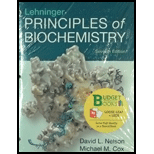
Concept explainers
(a)
To determine:
The ganglioside, which fits in the description given in the question.
Introduction:
Ganglioside is a
(b)
To determine:
The report of Svennerholm, that “90% of the monosialogangliosides from a patient with Tay-Sachs had a molar ratio of 1:2:1:1” is consistent with the Box 10-1 figure.
Introduction:
Tay-Sachs is a central nervous system disease, which commonly affects the children of 4-5 years old. This disease is caused by a defective gene (HEX-A) on the chromosome 1. The defect in the HEX-A gene causes the body to not synthesize a protein called hexosaminidase. The deficiency of this protein causes the accumulation of the gangliosides in the nerve cells of the brain, that leading a brain failure.
(c)
To determine:
The conclusion, a person can obtain from the structure of the normal ganglioside, and determine the resulting structure is consistent with the structure in Box 10-1.
Introduction:
Gangliosides are the biomolecules composed of glycosphingolipids. They consist a sialic acid like n-acetylneuraminic acid (NANA) that forms the anionic head groups of the gangliosides. Gangliosides are found in the cell membrane and the main function of these molecules is to modulate the cell signal transduction processes. The hydrophilic unit of the ganglioside is the sialic acid, and hydrophobic unit is sphingosine.
(d)
To determine:
The conclusion, a person can obtain from the structure of the Tay-Sachs ganglioside, and determine the resulting structure is consistent with the structure in Box 10-1.
Introduction:
Tay-Sachs is a genetic disorder of central nervous system, in which the brain cells destroyed due to the deficiency of the protein hexosaminidase. In this disorder, a defect occurs in the gene HEX-A, which is responsible for the protein hexosaminidase. Whereas, Gangliosides are the biomolecules found in the cell membrane and composed of glycosphingolipids. The main function of these molecules is to modulate the cell signal transduction processes.
(e)
To determine: The sugar of GM1 that each of the permethylated sugars corresponds.
Introduction:
Monosialotetrahexosylganglioside (GM1) is the prototype of gangliosides that contain a sialic acid unit. GM1 plays an important role in neuronal plasticity and repair mechanisms. It is also responsible for the release of neutrophins in the Central Nervous System (CNS). GM1 also provides the binding site for the E. coli heat-labile enterotoxin and Cholera toxin.
(f)
To determine:
The missing pieces of information about the normal gangliosides structure based on all the data presented so far.
Introduction:
Gangliosides are found in the cell membrane and play an important role in modulating the cell signal transduction processes. Ganglioside are composed of glycosphingolipids. They consist of a sialic acid like n-acetylneuraminic acid (NANA) which makes the anionic head groups of the gangliosides.
Want to see the full answer?
Check out a sample textbook solution
Chapter 10 Solutions
Loose-leaf Version for Lehninger Principles of Biochemistry 7E & SaplingPlus for Lehninger Principles of Biochemistry 7E (Six-Month Access)
- Please helparrow_forwardThe following data were recorded for the enzyme catalyzed conversion of S -> P Question: what would the rate be at 5.0 x 10-5 M [S] and the enzyme concentration was doubled? Also, the rate given in the table is from product accumulation after 10 minuets of reaction time. Verify these rates represent a true initial rate (less than 5% turnover). Please helparrow_forwardThe following data was obtained on isocitrate lyase from an algal species. Identify the reaction catalyzed by this enzyme, deduce the KM and Vmax , and determine the nature of the inhibition by oxaloacetate. Please helparrow_forward
- In the table below, there are sketches of four crystals made of positively-charged cations and negatively-charged anions. Rank these crystals in decreasing order of stability (or equivalently increasing order of energy). That is, select "1" below the most stable (lowest energy) crystal. Select "2" below the next most stable (next lowest energy) crystal, and so forth. A B 鹽 (Choose one) +2 C +2 +2 (Choose one) D 鹽雞 (Choose one) (Choose one)arrow_forward1. Draw the structures for the fats A. 16:2: w-3 and B. 18:3:49,12,15 2. Name each of the molecules below (image attached)arrow_forwarddraw the structures for the fats A. 16:2:w-3 B 18:3:9,12,15arrow_forward
- 1. Below is a template strand of DNA. Show the mRNA and protein that would result. label the ends of the molecules ( refer to attached image)arrow_forwardAttach the followina labels to the diagram below: helicase, single stranded binding proteins, lagging strand, leading strand, DNA polymerase, primase, 5' ends (3), 3' ends (3) (image attached)arrow_forward1. How much energy in terms of ATP can be obtained from tristearin (stearate is 18:0) Show steps pleasearrow_forward
- Multiple choice urgent!!arrow_forward1. Write the transamination reaction for alanine. Indicate what happens next to each of the molecules in the reaction, and under what conditions it happens. 2.arrow_forwardCH3 17. Which one of the compounds below is the HNO3 H2 1. NaNO2, HCI Br₂ 1. LiAlH4 major organic product H2SO4 Ni 2. CuCN, KCN FeBr3 2. H₂O, H+ obtained from the following series of reactions? CH3 toluene CH3 CH3 Br Br Br CH3 CH3 && Br Br NH₂ A NH₂ NH₂ B C NH₂ ΝΗΣ D Earrow_forward
 BiochemistryBiochemistryISBN:9781319114671Author:Lubert Stryer, Jeremy M. Berg, John L. Tymoczko, Gregory J. Gatto Jr.Publisher:W. H. Freeman
BiochemistryBiochemistryISBN:9781319114671Author:Lubert Stryer, Jeremy M. Berg, John L. Tymoczko, Gregory J. Gatto Jr.Publisher:W. H. Freeman Lehninger Principles of BiochemistryBiochemistryISBN:9781464126116Author:David L. Nelson, Michael M. CoxPublisher:W. H. Freeman
Lehninger Principles of BiochemistryBiochemistryISBN:9781464126116Author:David L. Nelson, Michael M. CoxPublisher:W. H. Freeman Fundamentals of Biochemistry: Life at the Molecul...BiochemistryISBN:9781118918401Author:Donald Voet, Judith G. Voet, Charlotte W. PrattPublisher:WILEY
Fundamentals of Biochemistry: Life at the Molecul...BiochemistryISBN:9781118918401Author:Donald Voet, Judith G. Voet, Charlotte W. PrattPublisher:WILEY BiochemistryBiochemistryISBN:9781305961135Author:Mary K. Campbell, Shawn O. Farrell, Owen M. McDougalPublisher:Cengage Learning
BiochemistryBiochemistryISBN:9781305961135Author:Mary K. Campbell, Shawn O. Farrell, Owen M. McDougalPublisher:Cengage Learning BiochemistryBiochemistryISBN:9781305577206Author:Reginald H. Garrett, Charles M. GrishamPublisher:Cengage Learning
BiochemistryBiochemistryISBN:9781305577206Author:Reginald H. Garrett, Charles M. GrishamPublisher:Cengage Learning Fundamentals of General, Organic, and Biological ...BiochemistryISBN:9780134015187Author:John E. McMurry, David S. Ballantine, Carl A. Hoeger, Virginia E. PetersonPublisher:PEARSON
Fundamentals of General, Organic, and Biological ...BiochemistryISBN:9780134015187Author:John E. McMurry, David S. Ballantine, Carl A. Hoeger, Virginia E. PetersonPublisher:PEARSON





